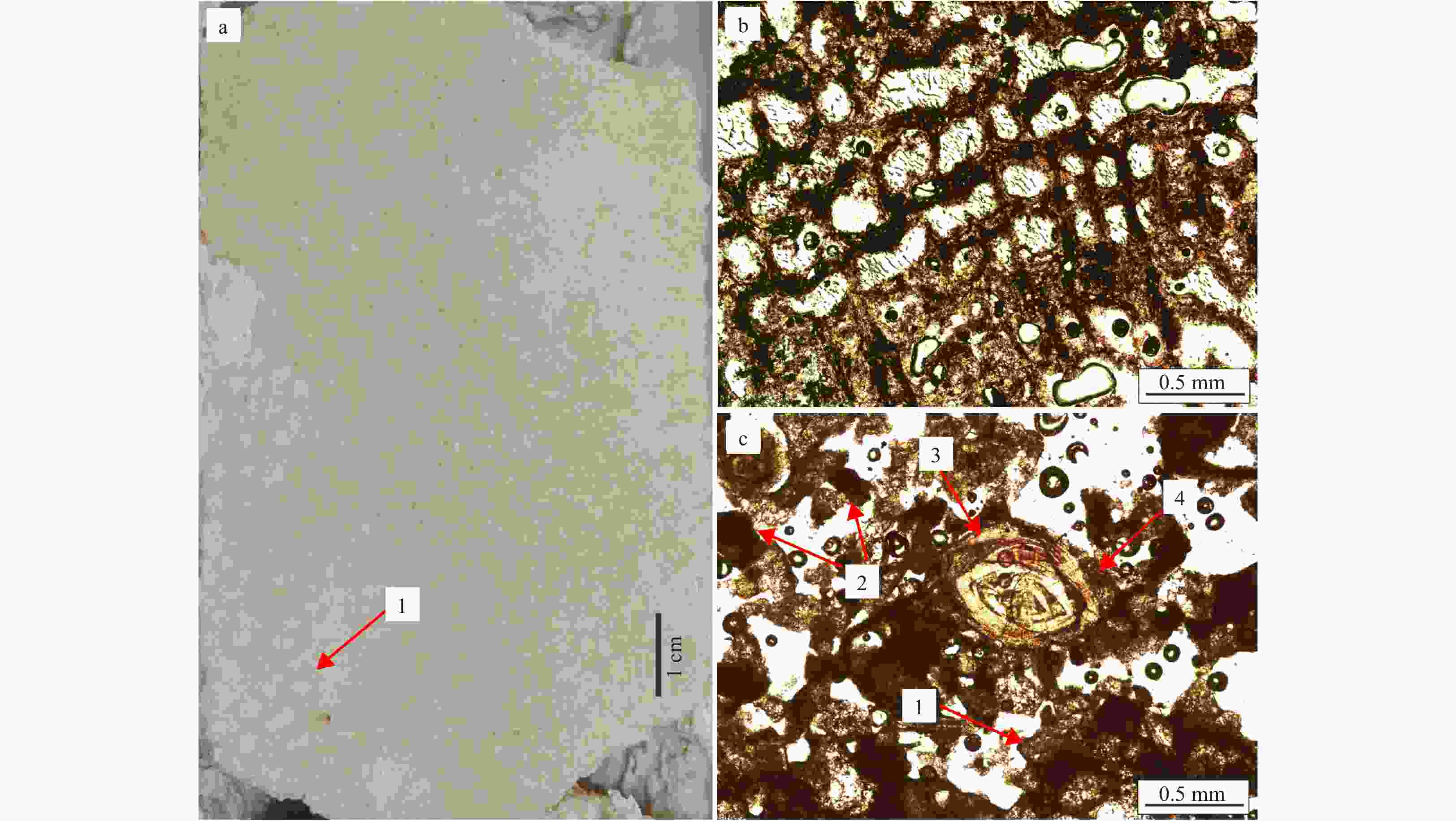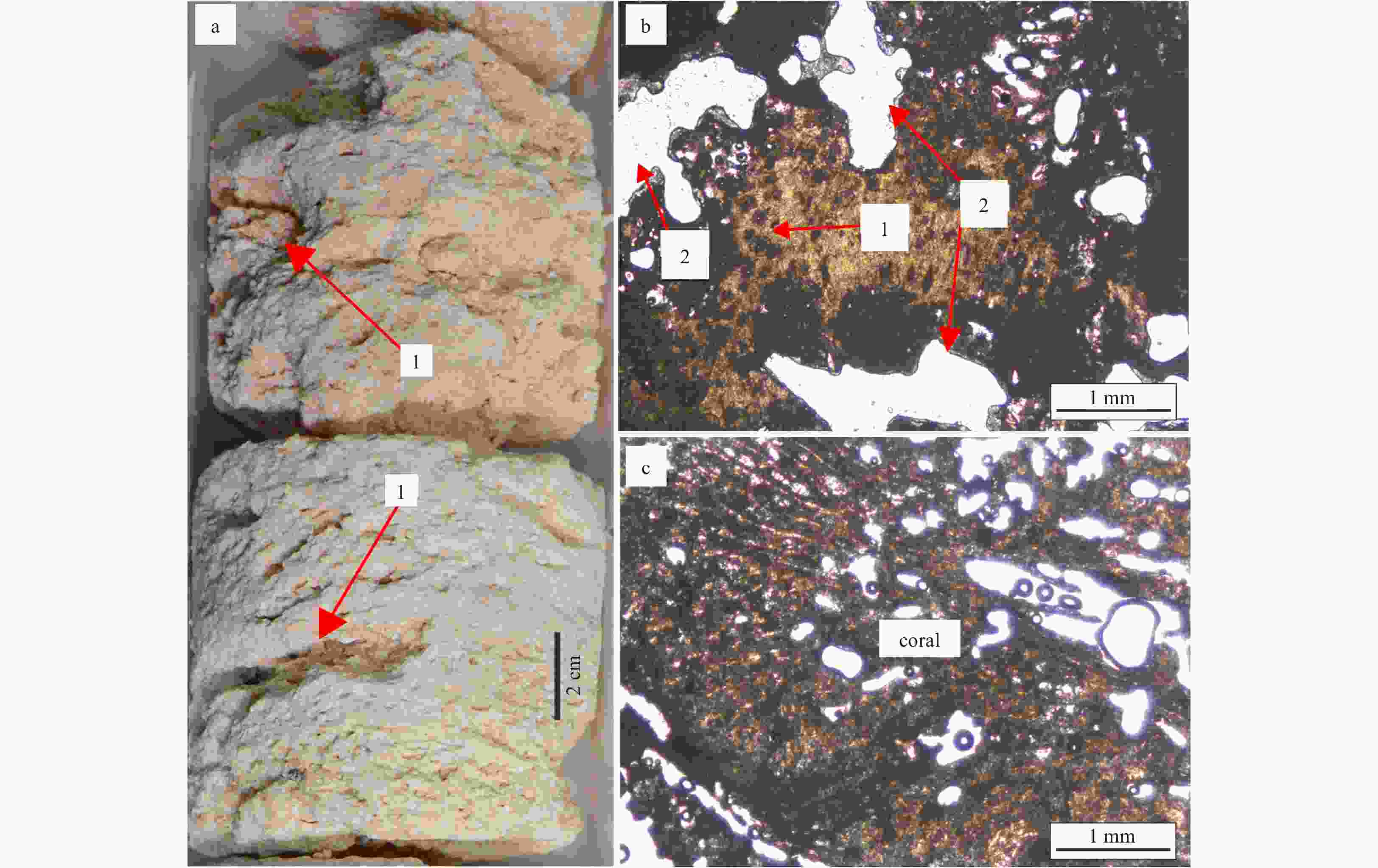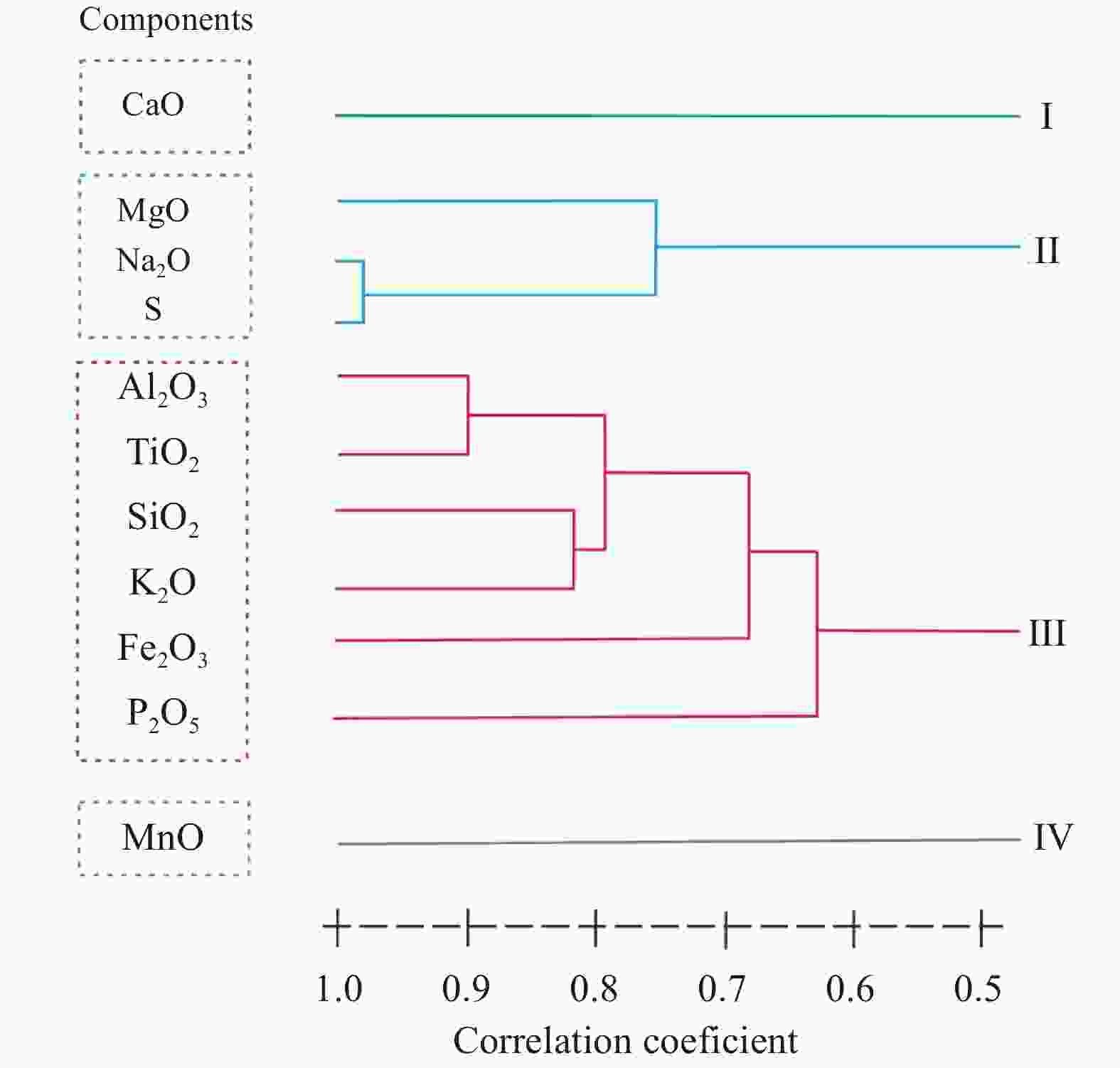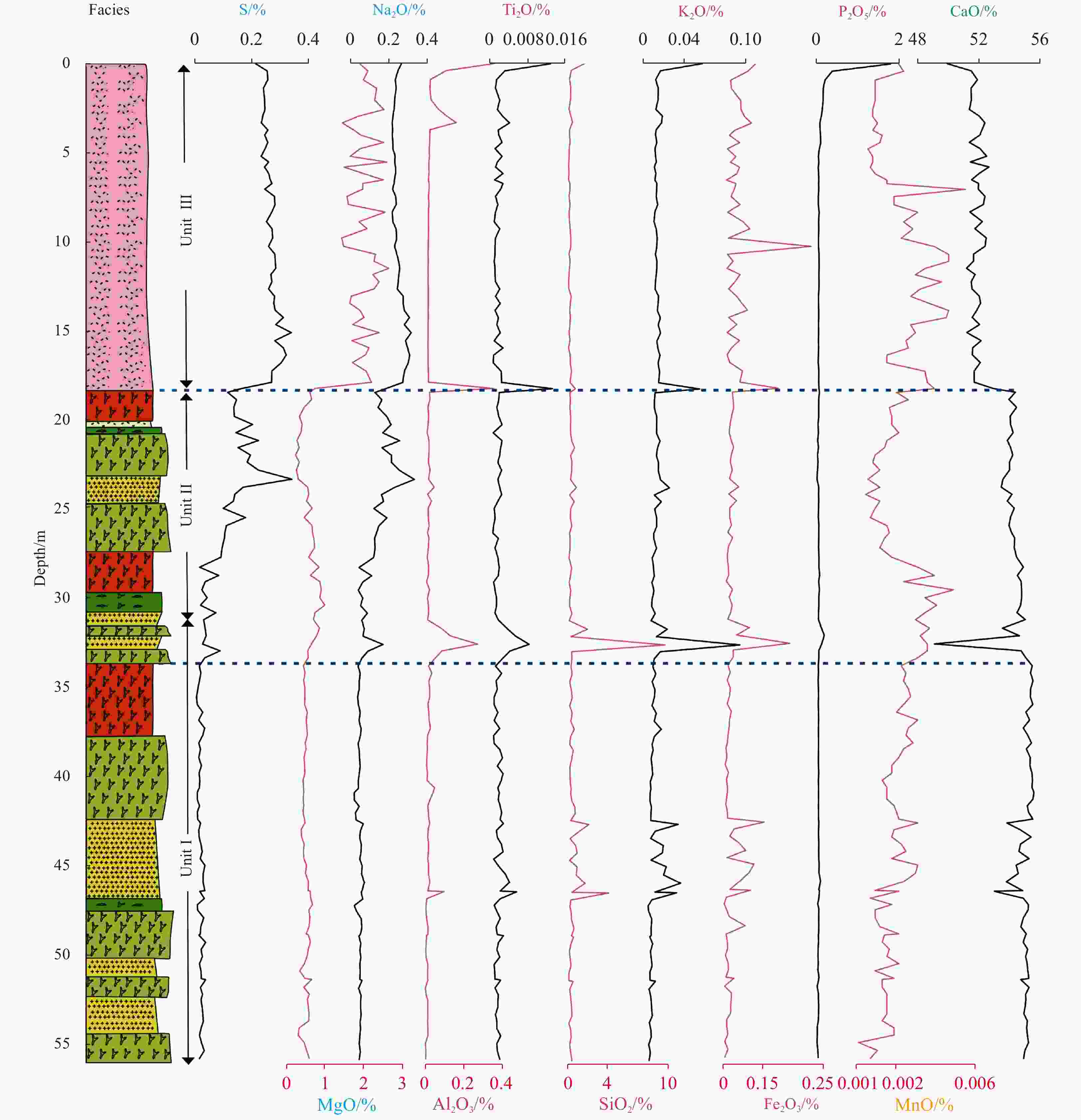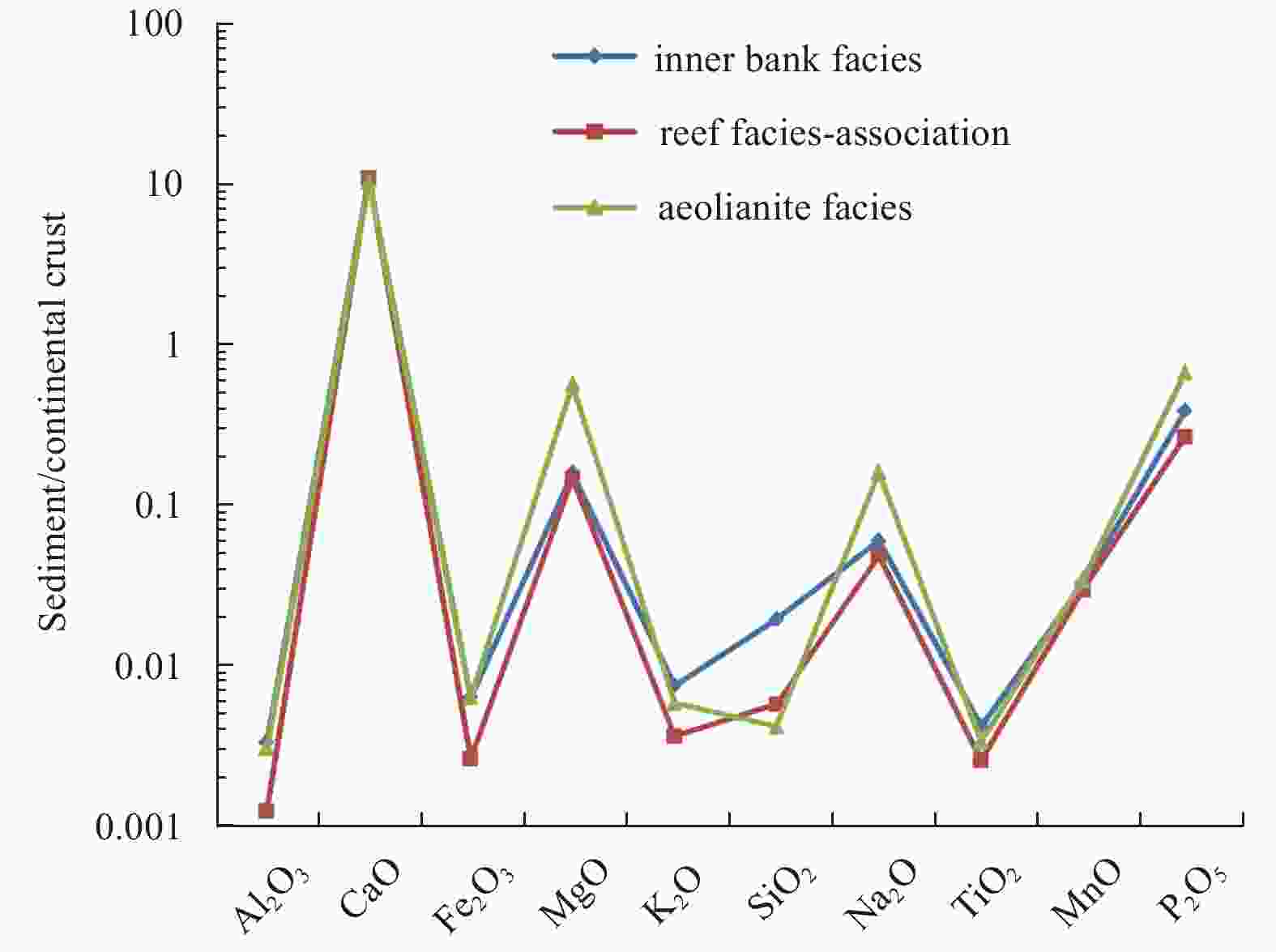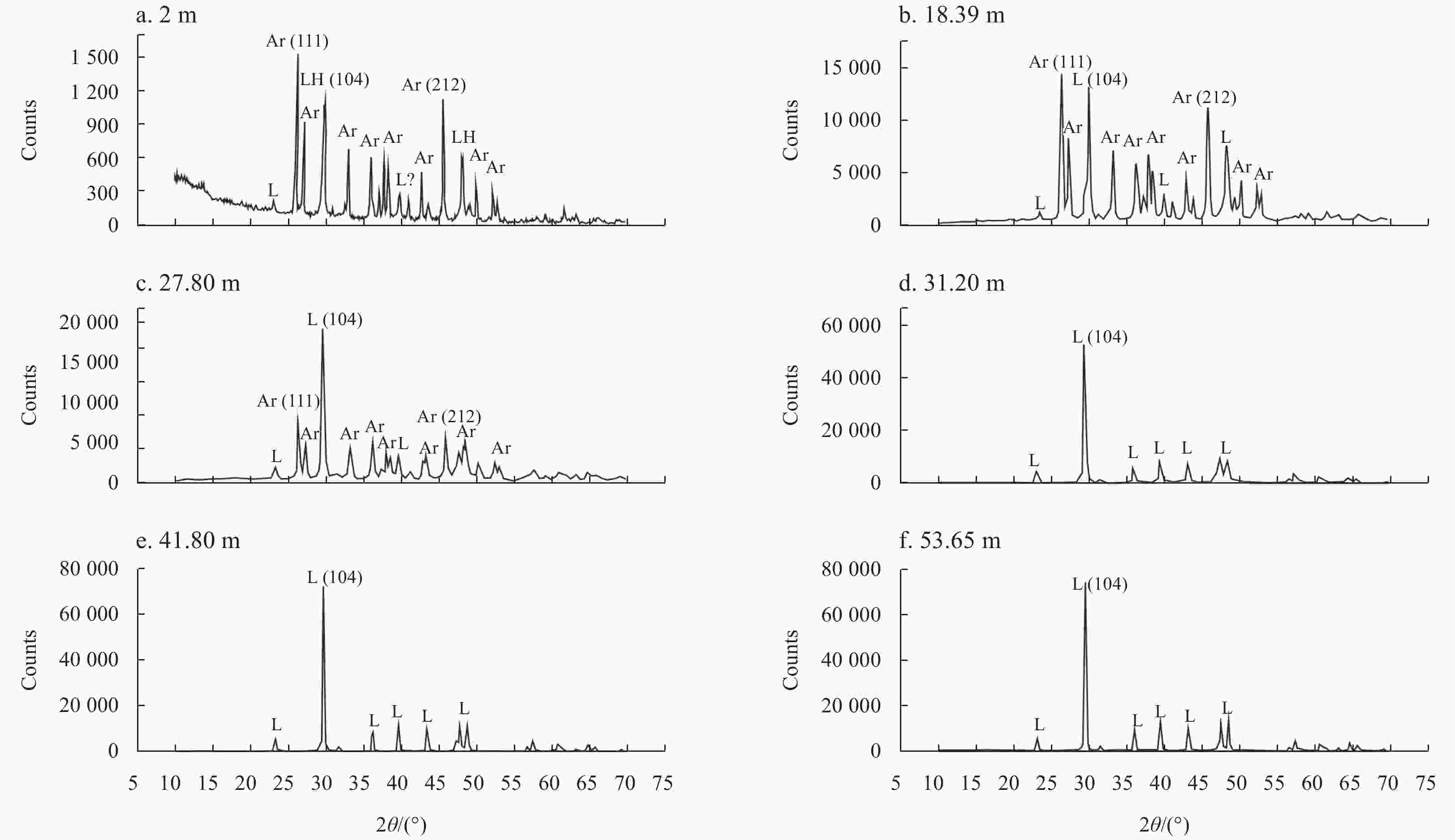Facies character and geochemical signature in the late Quaternary meteoric diagenetic carbonate succession at the Xisha Islands, South China Sea
-
Abstract: The late Quaternary shallow-water carbonates have been altered by a variety of diagenetic processes, and further influenced by high-amplitude global and regional sea level changes. This study utilizes a new borehole drilled on the Yongxing Island, Xisha Islands to investigate meteoric diagenetic alteration in the late Quaternary shallow-water carbonates. Petrographic, mineralogical, stable isotopic and elemental data provide new insights into the meteoric diagenetic processes of the reef limestone. The results show the variation in the distribution of aragonite, high-Mg calcite (HMC) and low-Mg calcite (LMC) divides the shallow-water carbonates in Core SSZK1 into three intervals, which are Unit I (31.20–55.92 m, LMC), Unit II (18.39–31.20 m, aragonite and LMC) and Unit III (upper 18.39 m of core, aragonite, LMC and HMC). Various degrees of meteoric diagenesis exist in the identified three units. The lowermost Unit I has suffered almost complete freshwater diagenesis, whereas the overlying Units II and III have undergone incompletely meteoric diagenesis. The amount of time that limestone has been in the freshwater diagenetic environment has the largest impact on the degree of meteoric diagenesis. Approximately four intact facies/water depth cycles are recognized. The cumulative depletion of elements such as strontium (Sr), sodium (Na) and sulphur (S) caused by duplicated meteoric diagenesis in the older reef sequences are distinguished from the younger reef sequences. This study provides a new record of meteoric diagenesis, which is well reflected by whole-rock mineralogy and geochemistry.
-
Figure 1. Location map of the Xisha Islands in the northern part of the South China Sea (a) and multibeam bathymetry map of the Xisha Islands (b). The bathymetry map in a has been generated by GMT software, and the data source is from https://www.ngdc.noaa.gov/mgg/bathymetry. In b, the black dot marks the Yongxing Island, and the SSZK1 borehole was drilled on the south of the Yongxing Island, Xuande Atoll.
Figure 2. Cross-section through the Xisha Platform showing the distribution of limestones and dolostones (a, adapted from Wang et al. (2018)), and integrated stratigraphic succession of Neogene rocks on the Xisha Islands showing the distribution of dolostones and limestones as well as diagenetic zones (b, adapted from Li et al. (2018)). The orange line in Fig. 1 indicates the location of the cross-section in a. In b, the stratigraphic reflectors (T20, T30, T40, T50, T60) were interpreted on seismic profiles shown by Wu et al. (2014).
Figure 3. Integrated data of late Quaternary strata of Core SSZK1: (1) chronostratigraphy based on ages come from U-Th dating results of the Well SSZK1 which propose the uppermost aeolianite facies formed after MIS 5; (2) facies; (3) variations in abundance of coral, red algae, green algae, benthic foraminifera and planktonic foraminifera; (4) vertical variations of carbonate and oxygen isotope; (5) correlation coefficients of carbonate and oxygen isotope vary in shallow-facies-dominated and deep-facies-dominated interlayer; and (6) mineralogical compositions of samples are concluded from analytical result of six samples and from the previous work in the nearby Wells XK-1 and XC-1 in the Xisha Islands (Liu et al., 1997, 2019). ARAG-aragonite, HMC- high-Mg calcite, LMC- low-Mg calcite.
Figure 4. Coral reef facies. a. Core photo of coral framestone: 1. Favia, 22.56–22.64 m; b. plane-polarized photomicrograph of coral framestone, 23.70 m; and c. plane-polarized photomicrograph of coral-debris dominated packstone, formed in the interstices between coral colonies: 1. coral fragments, 2. red algal fragments, 3. Amphistegina lobifera, and 4. micritic envelopes, 34.15 m.
Figure 6. Reef cap facies. a. Core photo of iron oxide-stained coral framestone: 1. Karst cave, 27.40–27.57 m; b. plane-polarized photomicrograph of coral framestone showing intense leaching of bioclasts, at least leached coral fragments are distinguished from their cortical coatings, formed by original intergranular porosity occlusion: 1. Porites, and 2. coral moldic pores, 28.93 m; and c. plane-polarized photomicrograph of coral framestone with coral moldic pores, 37.05 m.
Figure 7. Inner bank facies, outer bank facies and aeolinite facies. a. Plane-polarized photomicrograph of grainstone in inner bank facies, exhibiting subangular and poorly-sored bioclasts: 1. Amphistegina lessonii, 2. Globorotalia truncatulinoides, and 3. Halimeda, 23.98 m; b. plane-polarized photomicrograph of packstone in inner bank facies, exhibiting subangular and poorly-sored bioclasts: 1. Cibicidoides subhaidingerii (Parr) and 2. red algae, 32.70 m; c. cross-polarized photomicrograph of packstone in inner facies, showing the occurrence of quartz, 46.35 m; d. plane-polarized photomicrograph of grainstone in outer bank facies, showing planktonic foraminifera-rich bioclastic fragments: 1. planktonic foraminifera, 20.20 m.
Figure 8. Plane-polarized photomicrographs of products of meteoric diagenesis. a. Neomorphosed coral skeleton showing sparry calcite enclosed by microcrystalline calcite, 34.55 m. b. Micrite envelopes (red arrow), 33.20 m. c. Dissolved bioclasts, leaving molds with micrite envelope (red arrow), 42.5 m. d. Grains are connected by meniscus calcite cements causing round pore (red arrow), 32.9 m. e. Isopachous fibrous calcite fringe around grains; dissolution also occur on these early generated fibrous cements (red arrow), 25.14 m. f. Isopachous dogtooth calcite cements (red arrow), surrounding bioclasts, 47 m.
Figure 10. Vertical profile of facies and major elements variations, for symbols see legend in Fig. 3. The different colors of line titles mean different clusters of major elements.
Figure 11. Continental crust normalized major element composition (average value) for the reef facies-association, inner bank facies and aeolianite facies. Normalized values are from Taylor and McLennan (1985).
Figure 12. Dominant diagenetic environment at the uppermost 60 m depth intervals of Cores SSZK1 (a), XK-1 (b) and XC-1 (c) based on stable isotopic and mineralogical data. The previous work on Core XK-1 is from Liu et al. (2019) and Core XC-1 is from Liu et al. (1997). HMC: high-Mg calcite; LMC: low-Mg calcite.
Figure 13. The gradual decrease of S, Na2O and Sr content associated with stable isotopic values in different stage, for symbols see legend in Fig. 3. The dash line marks the ladder reduction of the average S, Na2O and Sr concentration in different depth intervals.
Table 1. Results of X-ray diffraction (XRD) analyses in samples
Depth/m Aragonite/% High-Mg calcite/% Low-Mg calcite/% 2.00 54.7 23.5 21.8 18.39 76.4 0 23.6 27.80 43.6 0 56.4 31.20 0 0 100.0 43.80 0 0 100.0 53.65 0 0 100.0 Table 2. Descriptive statistics of major elements analysis results in reef facies-association, inner bank facies and aeolianite facies in comparison with the continental crust
Al2O3 CaO Fe2O3 MgO K2O SiO2 Na2O TiO2 MnO P2O5 S Reef facies-association Average 0.019 54.850 0.016 0.522 0.009 0.355 0.151 0.002 0.003 0.044 0.224 Max 0.144 55.561 0.102 0.980 0.034 2.115 0.512 0.006 0.005 0.183 0.006 Min 0.001 53.795 0.003 0.227 0.004 0.116 0.031 0.001 0.001 0.008 0.053 Inner bank facies Average 0.050 54.164 0.039 0.561 0.019 1.183 0.187 0.003 0.003 0.063 0.342 Max 0.300 55.380 0.166 0.889 0.094 9.736 0.667 0.008 0.005 0.183 0.014 Min 0.010 49.054 0.009 0.298 0.007 0.139 0.075 0.001 0.001 0.008 0.063 Aeolianite facies Average 0.046 51.798 0.039 1.973 0.015 0.258 0.494 0.002 0.003 0.109 0.340 Max 0.400 52.897 0.219 2.634 0.057 1.764 0.633 0.013 0.006 1.770 0.165 Min 0.016 49.901 0.009 0.725 0.010 0.081 0.363 0.001 0.002 0.035 0.266 Continental crust 15.040 5.390 6.170 3.670 2.580 61.710 3.180 0.670 0.090 0.170 – Table 3. The correlations of main elements in SSZK1 carbonate profile
Al2O3 CaO Fe2O3 MgO K2O SiO2 Na2O TiO2 MnO P2O5 S Sr Al2O3 1 CaO –0.34 1 Fe2O3 0.57 –0.43 1 MgO 0.08 –0.88 0.17 1 K2O 0.79 –0.48 0.68 0.09 1 SiO2 0.52 –0.21 0.53 0.15 0.82 1 Na2O 0.15 –0.88 0.26 0.75 0.26 –0.07 1 TiO2 0.90 –0.24 0.52 0.02 0.76 0.50 0.06 1 MnO 0.15 –0.21 0.30 0.23 0.23 0.14 0.09 0.13 1 P2O5 0.63 –0.30 0.22 0.19 0.42 0.16 0.16 0.58 0.02 1 S 0.07 –0.87 0.20 0.82 0.14 –0.19 0.98 –0.01 0.09 0.11 1 Sr 0.09 –0.75 0.21 0.61 0.15 –0.17 0.93 0.02 –0.02 0.10 0.92 1 Note: Correlation coefficients larger than 0.5 (P<0.01, n=138) are marked by bold numbers. Table 4. 230Th dating results for corals from Core SSZK1, Yongxing Island
Depth/m [U]/10–6 234U/238U 234U/238U (initial) 230Th/238U 230Th/232Th Age/a BP Error (2σ) 7.21 0.816 1.147 1.149 0.047 3 59.4 4 239 246 13.47 2.450 1.141 1.144 0.082 1 7 090.3 8 114 190 18.39 2.490 1.126 1.153 0.539 0 1 178.8 69 795 274 24.30 2.946 1.121 1.155 0.630 0 2 886.6 88 094 349 30.11 1.028 1.110 1.214 1.010 0 709.8 236 524 2 131 42.52 0.891 1.104 1.260 1.083 0 710.0 329 184 5 601 44.89 1.279 1.097 1.294 1.102 0 1 456.1 392 344 9 658 55.92 1.000 1.087 1.337 1.107 0 1 227.7 479 636 19 388 Note: The unreliable dating results are marked by bold numbers. A1. Detection limit of the analytical method
Element Analytical method Detection limit CaO XRF 0.032 2 (10–2) MgO XRF 0.003 0 (10–2) Al2O3 XRF 0.002 7 (10–2) Fe2O3 XRF 0.002 7 (10–2) Na2O XRF 0.040 2 (10–2) SiO2 XRF 0.004 0 (10–2) K2O XRF 0.002 2 (10–2) P2O5 XRF 0.000 9 (10–2) MnO XRF 0.002 3 (10–4) TiO2 XRF 0.001 0 (10–2) S XRF 0.000 6 (10–2) Sr ICP-MS 1.000 0 (10–6) -
[1] Allan J R, Matthews R K. 1982. Isotope signatures associated with early meteoric diagenesis. Sedimentology, 29(6): 797–817. doi: 10.1111/j.1365-3091.1982.tb00085.x [2] Amirshahkarami M, Karavan M. 2015. Microfacies models and sequence stratigraphic architecture of the Oligocene-Miocene Qom Formation, south of Qom City, Iran. Geoscience Frontiers, 6(4): 593–604. doi: 10.1016/j.gsf.2014.08.004 [3] Ayers J F, Vacher H L. 1986. Hydrogeology of an atoll island: a conceptual model from detailed study of a micronesian example. Groundwater, 24(2): 185–198. doi: 10.1111/j.1745-6584.1986.tb00994.x [4] Beach D K. 1995. Controls and effects of subaerial exposure on cementation and development of secondary porosity in the subsurface of Great Bahama Bank. In: Budd D A, Saller A H, Harris P M, eds. Unconformities and Porosity in Carbonate Strata. Tulsa, American: American Association of Petroleum Geologists, 1–15 [5] Boggs S. 2009. Petrology of Sedimentary Rocks. 2nd ed. Cambridge: Cambridge University Press, 1–600 [6] Buchbinder L G, Friedman G M. 1980. Vadose, phreatic, and marine diagenesis of Pleistocene-Holocene carbonates in a borehole; Mediterranean coast of Israel. Journal of Sedimentary Research, 50(2): 395–407 [7] Budd D A, Land L S. 1990. Geochemical imprint of meteoric diagenesis in Holocene ooid sands, Schooner Cays, Bahamas; correlation of calcite cement geochemistry with extant groundwaters. Journal of Sedimentary Research, 60(3): 361–378 [8] Cantalejo B, Pickering K T. 2014. Climate forcing of fine-grained deep-marine systems in an active tectonic setting: middle Eocene, Ainsa Basin, Spanish Pyrenees. Palaeogeography, Palaeoclimatology, Palaeoecology, 410: 351–371. doi: 10.1016/j.palaeo.2014.06.005 [9] Cheng H, Edwards R L, Hoff J, et al. 2000. The half-lives of uranium-234 and thorium-230. Chemical Geology, 169(1–2): 17–33. doi: 10.1016/S0009-2541(99)00157-6 [10] Coletti G, Basso D, Corselli C. 2018. Coralline algae as depth indicators in the Sommières Basin (early Miocene, southern France). Geobios, 51(1): 15–30. doi: 10.1016/j.geobios.2017.12.002 [11] Coyne M K, Jones B, Ford D. 2007. Highstands during Marine Isotope Stage 5: evidence from the Ironshore Formation of Grand Cayman, British West Indies. Quaternary Science Reviews, 26(3-4): 536–559. doi: 10.1016/j.quascirev.2006.06.013 [12] Dang Haowen, Wang Tingting, Qiao Peijun, et al. 2019. The B/Ca and Cd/Ca of a subsurface-dwelling foraminifera Pulleniatina obliquiloculata in the tropical Indo-Pacific Ocean: implications for the subsurface carbonate chemistry estimation. Acta Oceanologica Sinica, 38(3): 138–150. doi: 10.1007/s13131-019-1406-6 [13] Derry L A, Kaufman A J, Jacobsen S B. 1992. Sedimentary cycling and environmental change in the Late Proterozoic: evidence from stable and radiogenic isotopes. Geochimica et Cosmochimica Acta, 56(3): 1317–1329. doi: 10.1016/0016-7037(92)90064-P [14] Dickson J A D. 1985. Diagenesis of shallow-marine carbonates. In: Brenchley P J, Williams B P J, eds. Sedimentology Recent Developments and Applied Aspects. London: Geological Society, London, Special Publications, 173–188 [15] Dunham R J. 1962. Classification of carbonate rocks according to depositional textures. In: Ham, W E, ed. Classification of Carbonate Rocks—A Symposium. Tulsa: AAPG, 108–121 [16] Eberli G P. 2000. The record of Neogene sea-level changes in the prograding carbonates along the Bahamas Transect—Leg 166 Synthesis. In: Swart P K, Eberli G P, Malone M J, et al, eds. Proceedings of the Ocean Drilling Program, Scientific Results. 166: College Station, TX (Ocean Driling Program) [17] Embry Ⅲ A F, Klovan J E. 1971. A late devonian reef tract on northeastern Banks Island, N.W.T. Bulletin of Canadian Petroleum Geology, 19(4): 730–781 [18] Fan Tianlai, Yu Kefu, Zhao Jianxin, et al. 2020. Strontium isotope stratigraphy and paleomagnetic age constraints on the evolution history of coral reef islands, northern South China Sea. GSA Bulletin, 132(3–4): 803–816. doi: 10.1130/B35088.1 [19] Geel T. 2000. Recognition of stratigraphic sequences in carbonate platform and slope deposits: empirical models based on microfacies analysis of Palaeogene deposits in southeastern Spain. Palaeogeography, Palaeoclimatology, Palaeoecology, 155(3–4): 211–238. doi: 10.1016/S0031-0182(99)00117-0 [20] Gill B C, Lyons T W, Frank T D. 2008. Behavior of carbonate-associated sulfate during meteoric diagenesis and implications for the sulfur isotope paleoproxy. Geochimica et Cosmochimica Acta, 72(19): 4699–4711. doi: 10.1016/j.gca.2008.07.001 [21] Hajikazemi E, Al-Aasm I S, Coniglio M. 2010. Subaerial exposure and meteoric diagenesis of the Cenomanian-Turonian Upper Sarvak Formation, southwestern Iran. In: Leturmy P, Robin C, eds. Tectonic and Stratigraphic Evolution of Zagros and Makran during the Mesozoic–Cenozoic. London: Geological Society, London, Special Publications, 253–272 [22] Harrison R S. 1975. Porosity in Pleistocene grainstones from Barbados: some preliminary observations. Bulletin of Canadian Petroleum Geology, 23(3): 383–392 [23] Holail H. 1999. The isotopic composition and diagenetic history of pleistocene carbonates, North Qatar. Carbonates and Evaporites, 14(1): 41–45. doi: 10.1007/BF03176147 [24] Hu Jianyu, Kawamura H, Hong Huasheng, et al. 2000. A review on the currents in the South China Sea: Seasonal circulation, South China Sea warm current and Kuroshio Intrusion. Journal of Oceanography, 56(6): 607–624. doi: 10.1023/A:1011117531252 [25] Huang Xiaoxia, Betzler C, Wu Shiguo, et al. 2020. First documentation of seismic stratigraphy and depositional signatures of Zhongsha atoll (Macclesfield Bank), South China Sea. Marine and Petroleum Geology, 117: 104349. doi: 10.1016/j.marpetgeo.2020.104349 [26] Jiang Wei, Yu Kefu, Fan Tianlai, et al. 2019. Coral reef carbonate record of the Pliocene-Pleistocene climate transition from an atoll in the South China Sea. Marine Geology, 411: 88–97. doi: 10.1016/j.margeo.2019.02.006 [27] Kaufman A J, Jacobsen S B, Knoll A H. 1993. The Vendian record of Sr and C isotopic variations in seawater: implications for tectonics and paleoclimate. Earth and Planetary Science Letters, 120(3–4): 409–430. doi: 10.1016/0012-821X(93)90254-7 [28] Kaufman A J, Knoll A H. 1995. Neoproterozoic variations in the C-isotopic composition of seawater: stratigraphic and biogeochemical implications. Precambrian Research, 73(1–4): 27–49. doi: 10.1016/0301-9268(94)00070-8 [29] Kroeger K F, Reuter M, Brachert T C. 2006. Palaeoenvironmental reconstruction based on non-geniculate coralline red algal assemblages in Miocene limestone of central Crete. Facies, 52(3): 381–409. doi: 10.1007/s10347-006-0077-x [30] Ku T L, Mathieu G G, Knauss K G. 1977. Uranium in open ocean: concentration and isotopic composition. Deep Sea Research, 24(11): 1005–1017. doi: 10.1016/0146-6291(77)90571-9 [31] Lei Yanli, Li Tiegang. 2016. Atlas of Benthic Foraminifera from China Seas the Bohai Sea and the Yellow Sea. Berlin Heidelberg: Springer-Verlag, 1–399 [32] Li Rong, Qiao Peijun, Cui Yuchi, et al. 2018. Composition and diagenesis of Pleistocene aeolianites at Shidao, Xisha Islands: implications for palaeoceanography and palaeoclimate during the last glacial period. Palaeogeography, Palaeoclimatology, Palaeoecology, 490: 604–616. doi: 10.1016/j.palaeo.2017.11.049 [33] Liao Zibo, Shao Qingfeng, Li Chunhua, et al. 2018. Measurement of U/Th isotopic compositions in stalagmites for 230Th/U geochronology using MC-ICP-MS by standard-sample bracketing method. Journal of Chinese Mass Spectrometry Society (in Chinese), 39(3): 295–309 [34] Liu Jian, Han Chunrui, Wu Jianzheng, et al. 1998. Geochemical evidence for the meteoric diagenesis in Pleistocene reef limestones of Xisha islands. Acta Sedimentologica Sinica (in Chinese), 16(4): 71–77 [35] Liu Na, Wang Zhenfeng, Li Xushen, et al. 2019. Reef-carbonate diagenesis in the Pleistocene-Holocene of the well Xike#1, Xisha Islands, South China Sea: implications on sea-level changes. Carbonates and Evaporites, 34(4): 1669–1687. doi: 10.1007/s13146-019-00515-1 [36] Liu Jian, Ye Zhizheng, Han Chunrui, et al. 1997. Meteoric diagenesis in Pleistocene reef limestones of Xisha Islands, China. Journal of Asian Earth Sciences, 15(6): 465–476. doi: 10.1016/S0743-9547(97)00049-4 [37] Lohmann K C. 1988. Geochemical patterns of meteoric diagenetic systems and their application to studies of paleokarst. In: James N P, Choquette P W, eds. Paleokarst. New York: Springer, 58–80 [38] Ma Zhaoliang, Li Qianyu, Liu Xinyu, et al. 2018. Palaeoenvironmental significance of Miocene larger benthic foraminifera from the Xisha Islands, South China Sea. Palaeoworld, 27(1): 145–157. doi: 10.1016/j.palwor.2017.05.007 [39] Ma Yubo, Wu Shiguo, Lv Fuliang, et al. 2011. Seismic characteristics and development of the Xisha carbonate platforms, northern margin of the South China Sea. Journal of Asian Earth Sciences, 40(3): 770–783. doi: 10.1016/j.jseaes.2010.11.003 [40] Martin G D, Wilkinson B H, Lohmann K C. 1986. The role of skeletal porosity in aragonite neomorphism-Strombus and Montastrea from the Pleistocene Key Largo Limestone, Florida. Journal of Sedimentary Research, 56(2): 194–203 [41] Matthews R K. 1968. Carbonate diagenesis: equilibration of sedimentary mineralogy to the subaerial environment; coral cap of barbados, West Indies. Journal of Sedimentary Research, 38(4): 1110–1119 [42] Matthews R K, Frohlich C. 1987. Forward modeling of bank-margin carbonate diagenesis. Geology, 15(7): 673–676. doi: 10.1130/0091-7613(1987)15<673:FMOBCD>2.0.CO;2 [43] McGregor H V, Gagan M K. 2003. Diagenesis and geochemistry of porites corals from Papua New Guinea: implications for paleoclimate reconstruction. Geochimica et Cosmochimica Acta, 67(12): 2147–2156. doi: 10.1016/S0016-7037(02)01050-5 [44] Melim L A. 1996. Limitations on lowstand meteoric diagenesis in the Pliocene-Pleistocene of Florida and Great Bahama Bank: implications for eustatic sea-level models. Geology, 24(10): 893–896. doi: 10.1130/0091-7613(1996)024<0893:LOLMDI>2.3.CO;2 [45] Melim L A, Westphal H, Swart P K, et al. 2002. Questioning carbonate diagenetic paradigms: evidence from the Neogene of the Bahamas. Marine Geology, 185(1–2): 27–53. doi: 10.1016/S0025-3227(01)00289-4 [46] Perry C T, Morgan K M, Salter M A. 2016. Sediment generation by Halimeda on atoll interior coral reefs of the southern Maldives: a census-based approach for estimating carbonate production by calcareous green algae. Sedimentary Geology, 346: 17–24. doi: 10.1016/j.sedgeo.2016.10.005 [47] Quinn T M. 1991. Meteoric diagenesis of plio-pleistocene limestones at enewetak atoll. Journal of Sedimentary Research, 61(5): 681–703 [48] Radtke U, Schellmann G. 2005. Timing and magnitude of sea level change during MIS 5 derived from barbados coral reef terraces: a critical literature review and New Data. Journal of Coastal Research, 21: 52–62 [49] Raymo M E, Oppo D W, Curry W. 1997. The Mid-Pleistocene climate transition: a deep sea carbon isotopic perspective. Paleoceanography, 12(4): 546–559. doi: 10.1029/97PA01019 [50] Robinson L F, Belshaw N S, Henderson G M. 2004. U and Th concentrations and isotope ratios in modern carbonates and waters from the Bahamas. Geochimica et Cosmochimica Acta, 68(8): 1777–1789. doi: 10.1016/j.gca.2003.10.005 [51] Ruddiman W F, Raymo M E, Martinson D G, et al. 1989. Pleistocene evolution: northern hemisphere ice sheets and North Atlantic Ocean. Paleoceanography, 4(4): 353–412. doi: 10.1029/PA004i004p00353 [52] Saller A H, Moore C H Jr. 1989. Meteoric diagenesis, marine diagenesis, and microporosity in Pleistocene and Oligocene limestones, Enewetak Atoll, Marshall Islands. Sedimentary Geology, 63(3–4): 253–272. doi: 10.1016/0037-0738(89)90135-8 [53] Saller A H, Moore C H Jr. 1991. Geochemistry of meteoric calcite cements in some Pleistocene limestones. Sedimentology, 38(4): 601–621. doi: 10.1111/j.1365-3091.1991.tb01011.x [54] Shao Lei, Cui Yuchi, Qiao Peijun, et al. 2017a. Sea-level changes and carbonate platform evolution of the Xisha Islands (South China Sea) since the Early Miocene. Palaeogeography, Palaeoclimatology, Palaeoecology, 485: 504–516. doi: 10.1016/j.palaeo.2017.07.006 [55] Shao Lei, Li Qianyu, Zhu Weilin, et al. 2017b. Neogene carbonate platform development in the NW South China Sea: litho-, bio- and chemo-stratigraphic evidence. Marine Geology, 385: 233–243. doi: 10.1016/j.margeo.2017.01.009 [56] Sherman C E, Fletcher C H, Rubin K H. 1999. Marine and meteoric diagenesis of Pleistocene carbonates from a nearshore submarine terrace, Oahu, Hawaii. Journal of Sedimentary Research, 69(5): 1083–1097. doi: 10.2110/jsr.69.1083 [57] Shi Xiaobin, Zhou Di, Qiu Xuelin, et al. 2002. Thermal and rheological structures of the Xisha Trough, South China Sea. Tectonophysics, 351(4): 285–300. doi: 10.1016/S0040-1951(02)00162-2 [58] Sun Zhen, Stock J, Klaus A, et al. 2016. Expedition 367/368 scientific prospectus: South China Sea rifted margin. USA: International Ocean Discovery Program [59] Sun Zhen, Wang Zhenfeng, Sun Zhipeng, et al. 2015. Structure and kinematic analysis of the deepwater area of the Qiongdongnan Basin through a seismic interpretation and analogue modeling experiments. Acta Oceanologica Sinica, 34(4): 32–40. doi: 10.1007/s13131-015-0585-z [60] Sun Youbin, Yin Qiuzhen, Crucifix M, et al. 2019. Diverse manifestations of the mid-Pleistocene climate transition. Nature Communications, 10(1): 352. doi: 10.1038/s41467-018-08257-9 [61] Surić M, Richards D A, Hoffmann D L, et al. 2009. Sea-level change during MIS 5a based on submerged speleothems from the eastern Adriatic Sea (Croatia). Marine Geology, 262(1–2): 62–67 [62] Swart P K. 2015. The geochemistry of carbonate diagenesis: the past, present and future. Sedimentology, 62(5): 1233–1304. doi: 10.1111/sed.12205 [63] Swart P K, Eberli G. 2005. The nature of the δ13C of periplatform sediments: implications for stratigraphy and the global carbon cycle. Sedimentary Geology, 175(1–4): 115–129. doi: 10.1016/j.sedgeo.2004.12.029 [64] Swart P K, Hubbard J A E B. 1982. Uranium in scleractinian coral skeletons. Coral Reefs, 1(1): 13–19. doi: 10.1007/BF00286535 [65] Swart P K, Oehlert A M, Mackenzie G J, et al. 2014. The fertilization of the Bahamas by Saharan dust: a trigger for carbonate precipitation?. Geology, 42(8): 671–674. doi: 10.1130/G35744.1 [66] Taylor S R, McClennan S M. 1985. The Continental Crust: Its Composition and Evolution. United States: Blackwell Scientific Publications, 1–312 [67] Tomás S, Homann M, Mutti M, et al. 2013. Alternation of microbial mounds and ooid shoals (Middle Jurasssic, Morocco): response to paleoenvironmental changes. Sedimentary Geology, 294: 68–82. doi: 10.1016/j.sedgeo.2013.05.008 [68] Wang Zhenfeng, Huang Keke, Zhang Daojun, et al. 2018b. Maturation of neogene dolomite from xuande atoll of Xisha archipelago, the South China Sea. Marine and Petroleum Geology, 92: 51–64. doi: 10.1016/j.marpetgeo.2018.02.016 [69] Wang Rui, Yu Kefu, Jones B, et al. 2018a. Evolution and development of Miocene “island dolostones” on Xisha Islands, South China Sea. Marine Geology, 406: 142–158. doi: 10.1016/j.margeo.2018.09.006 [70] Webster J M, Braga J C, Clague D A, et al. 2009. Coral reef evolution on rapidly subsiding margins. Global and Planetary Change, 66(1–2): 129–148. doi: 10.1016/j.gloplacha.2008.07.010 [71] Weinmann A E, Goldstein S T, Triantaphyllou M V, et al. 2019. Effects of sampling site, season, and substrate on foraminiferal assemblages grown from propagule banks from lagoon sediments of Corfu Island (Greece, Ionian Sea). PLoS One, 14(6): e0219015. doi: 10.1371/journal.pone.0219015 [72] Wienberg C, Frank N, Mertens K N, et al. 2010. Glacial cold-water coral growth in the Gulf of Cádiz: implications of increased palaeo-productivity. Earth and Planetary Science Letters, 298(3–4): 405–416. doi: 10.1016/j.jpgl.2010.08.017 [73] Wu Shiguo, Chen Wanli, Huang Xiaoxia, et al. 2020. Facies model on the modern isolated carbonate platform in the Xisha Archipelago, South China Sea. Marine Geology, 425: 106203. doi: 10.1016/j.margeo.2020.106203 [74] Wu Feng, Xie Xinong, Betzler C, et al. 2019. The impact of eustatic sea-level fluctuations, temperature variations and nutrient-level changes since the Pliocene on tropical carbonate platform (Xisha Islands, South China Sea). Palaeogeography, Palaeoclimatology, Palaeoecology, 514: 373–385. doi: 10.1016/j.palaeo.2018.10.013 [75] Wu Shiguo, Yang Zhen, Wang Dawei, et al. 2014. Architecture, development and geological control of the Xisha carbonate platforms, northwestern South China Sea. Marine Geology, 350: 71–83. doi: 10.1016/j.margeo.2013.12.016 [76] Wu Shiguo, Zhang Xinyuan, Yang Zhen, et al. 2016. Spatial and temporal evolution of Cenozoic carbonate platforms on the continental margins of the South China Sea: response to opening of the ocean basin. Interpretation, 4(3): SP1–SP19. doi: 10.1190/INT-2015-0162.1 [77] Xu Shendong, Yu Kefu, Fan Tianlai, et al. 2019. Coral reef carbonate δ13C records from the northern South China Sea: a useful proxy for seawater δ13C and the carbon cycle over the past 1.8 Ma. Global and Planetary Change, 182: 103003. doi: 10.1016/j.gloplacha.2019.103003 [78] Xu Hong, Zhao Xinwei, Eberli G P, et al. 2015. Biogenic carbonate formation and sedimentation in the Xisha Islands: evidences from living Halimeda. Acta Oceanologica Sinica, 34(4): 62–73. doi: 10.1007/s13131-015-0584-0 [79] Yi Liang, Jian Zhimin, Liu Xinyu, et al. 2018. Astronomical tuning and magnetostratigraphy of Neogene biogenic reefs in Xisha Islands, South China Sea. Science Bulletin, 63(9): 564–573. doi: 10.1016/j.scib.2018.04.001 [80] Zhao Yanyan, Li Sanzhong, Li Da, et al. 2019. Rare earth element geochemistry of carbonate and its paleoenvironmental implications. Geotectonica et Metallogenia (in Chinese), 43(1): 141–167 -





 下载:
下载:


